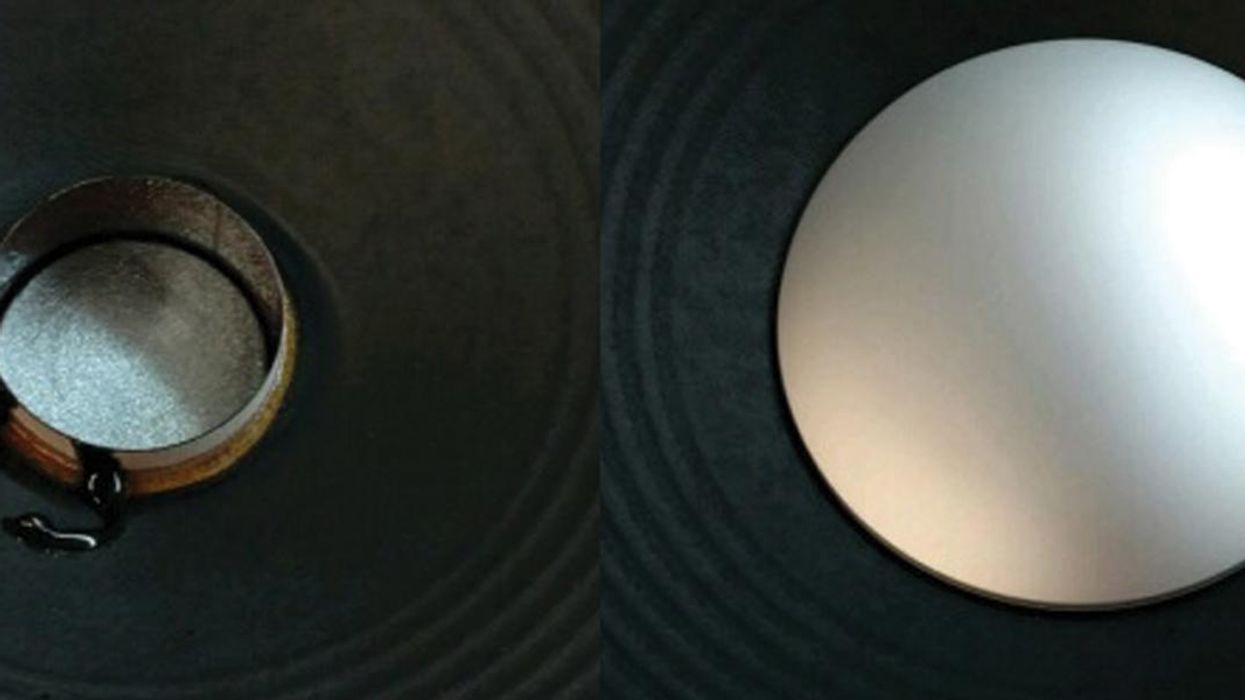“Hey man, I really like your guitar box thing."
“Oh, my amp? It's a '72 Fender Twin Reverb. I put new tubes in it, re-capped it, and modded the circuit for more—"
“Yeah, yeah, yeah, but I just really like the way you can see the metal dome or whatever through the grille. That looks so cool."
“Oh yeah, those are the original JBL speakers that came with—"
“Well, see ya later."
I'm sure a similar conversation has occurred many times between thousands of guitarists and bar-goers. Between gear geeks and non-musicians. And probably between thousands of other people who may not realize that the “metal dome or whatever" has a significant effect on the tone of the speaker (self-professed gear geeks included).
As we've learned previously in Speaker Geeks, the cone is responsible for the lion's share of a speaker's tone. In the center of the cone is an opening where the voice coil is attached, and the voice coil sits inside a gap created by the speaker's front plate and magnet pole. It is vital that the voice coil doesn't rub against either part. It's also very important that no foreign particles can get inside and wreak havoc. Enter the dustcap, so named because it prevents dust from getting in this gap.
Call it a dustcap, dustcover, dome, or any other word that begins with D, the primary function is to keep dust and debris out of the inner workings of the speaker. But as early speaker designers quickly learned, the shape, size, and material of the dustcap play a huge role in a speaker's sound, specifically the high end.
It's important to note that most of the treble comes from the center of the speaker, beaming out from the top of the magnet pole. As the sound waves travel from the center and up the cone and radiate out, any ribs or ridges in the cone also send treble forward and into your ears. Some of the earliest designs, like the '50s Jensen P10R, used a piece of felt as the dustcap. Standing guard against those pesky particles, it got the job done, but it wasn't terribly sophisticated. This type of material absorbs a lot of the high end and results in a warmer sound without a whole lot of detail.
In the late '50s and into the '60s, speakers saw a lot of development and experimentation. Some speakers were built with hard fiber dustcaps like you might see on a vintage C12Q or C12N. This harder material deflects some treble, but allows the majority to pass through and provide plenty of detail.
Another type of dome is a large screen, which diffuses much of the high end and provides a warmer sound. Its dome shape spreads out the highs more evenly. The larger size also means a greater distance from the magnet pole, so the treble hits the material a little farther out, which also helps with the diffusion. Many harmonica players like this kind of dome, because highs cause feedback, and a screen dome helps reduce or eliminate that.
The other big dustcap is the aforementioned metal dome, which is typically made of aluminum because of its heat-dispersing attributes. When you play guitar, the amp's output signal travels to the speaker where it is converted to electromagnetic energy to make the voice coil move … and heat. The latter builds up in the voice coil gap, which is usually no problem when you have a speaker with a higher power rating than the amp puts out. However, with larger amps that put out more power, the heat resistance of the voice coil material alone may not be enough. Different techniques are used to combat that heat buildup, including venting the heat out the back through a screen, through holes in the voice coil, or sometimes through vents in the dustcap itself. Aluminum domes have sufficient heat-resistance properties to stave off heat without a vent—at least the amount of heat we're talking about.
So you'll typically see aluminum domes on amps with high output ratings, like the Fender Twin Reverb, at 85 to 100 watts, and the Roland Jazz Chorus at 120 watts. And those domes sure look cool—especially on a stage with lights reflecting off them. Dazzling. But as anyone who has ever played a speaker with an aluminum dome knows, the high end can be pretty crispy. The hard aluminum material extends the high frequency range, too. Where a typical guitar speaker falls off around 5 kHz, an aluminum-domed speaker can go as high as 7 kHz. This extended high end can sound very pleasing for certain music, such as some jazz and surf, where the tone is uncompromisingly clean. But when you start adding overdrive, watch out. It can very quickly sound like a swarm of bees.
Maybe you want that kind of tone. Who am I to judge? But now at least you know there's more to a metal dome than its pretty looks, so you can make an informed decision on your next speaker acquisition.
















